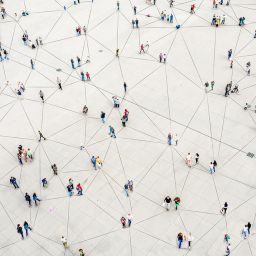In recent years, mental health has become a silent, profound and alarming crisis worldwide, which affects society as a whole. It also has a direct impact on the economy and business development.
The World Health Organization estimates that around 12.5% of the population — one in eight people — suffers from some type of mental health disorder. This is equivalent to more than 970 million people who suffer from conditions such as stress, depression or anxiety, or who have more serious ailments such as bipolar disorder, schizophrenia or developmental disorders.
Moreover, it is estimated that mental health problems have an even greater impact among adolescents, with close to one in seven teenagers being affected. The COVID-19 pandemic has accelerated these figures with a 25% increase in cases of anxiety and depression throughout the world.
Given the enormous scale of these statistics, it seems evident that psychological problems must be addressed on a global scale and from the perspective of public health systems. And yet, companies, managers and each one of us can take effective measures to mitigate mental health problems and improve quality of life, both for ourselves and in our surroundings. As is the case with any area of knowledge, we first need to break down the stigmas and be willing to learn.
Leadership and mental health: discover how neuroscience can help you take care of the well-being of your teams
The psychiatrist and author Marian Rojas Estapé gave a conference at the IESE campus in Madrid in which she covered fundamental neuroscientific concepts that can help us better understand some of the emotions that are most difficult for us to manage in our daily lives.
She also addressed how the pressures of our fast-paced modern lives affect our well-being and the extent to which integrating a neuroscientific perspective into leadership strategies can contribute to creating healthier, more empathetic, and more supportive work environments.
According to the vision of Marian Rojas, we must first of all dismantle the prejudices that exist around mental health, and we must do so using high doses of understanding. “We are all concerned about having a mind that works well and knowing how to manage our impulses and emotions,” she states. For this reason, she considers disclosure to be essential, because it helps us understand ourselves better and because, as she says, “to understand is to provide relief.”
“If we are understood, we feel relieved. If I understand why my eyelid trembles, why I don’t sleep well at night, why this person reminds me of this other person and I am thus unable to smile at them, or why I choose the wrong partners, I can start looking for solutions,” she explains.
Faced with a growing sense of psychological duress in society, which is especially widespread after the pandemic, Rojas proposes a three-phase diagnosis in which she describes the critical role that cortisol, dopamine and oxytocin play in our physical and mental well-being.

Cortisol and its impact on stress levels
Referred to as the stress hormone, cortisol is essential for our survival as it activates our fight-or-flight mode in the face of immediate danger. “Cortisol is a wonderful hormone,” says the psychiatrist, “because without it things would arise in our environment that we wouldn’t care about. A lion would appear and we would love for it to bite us. We wouldn’t be afraid, in other words.”
Problems arise when this hormone is constantly present in the bloodstream, since high and prolonged levels of cortisol are linked to sleep and attention disorders, inflammatory processes, infertility, depression, cardiovascular risk, intestinal dysfunctions, and a weakened immune system, among other conditions.
According to Rojas, “Nowadays we are intoxicated with cortisol.” For the author, it is essential to clarify that this fear hormone is activated when we feel that our physical, psychological, emotional, affective, or economic survival is at stake. “It doesn’t just appear in the face of a real threat, but also surges at the mere thought that something could happen to me or the people I love most. My body and my mind do not distinguish whether the cause is real or imaginary: the same alert mechanism is activated whether I am being mugged or if my boss tells me that he needs to talk to me tomorrow,” she states.
The author goes on to say that “it is estimated that 91.4% of the things that we worry about will actually never happen. However, thinking about them has a direct impact on our physical and psychological health. That is the key to the neuroscience of emotions: what I allow to be important directly influences my health.”
For Marian Rojas, two of the most important effects of an excess of cortisol in the body are the blockage of the prefrontal cortex — “the part of the brain which reflects and empathizes, and which manages impulses” — along with the depressive processes — “many types of sadness come from living in a state of alertness for many years.”
Today, fear and stress dominate the lives of millions of people. For this reason, the author recommends identifying the factors that most intoxicate our bodies with cortisol and protecting ourselves from them as much as possible.
Dopamine and the rise of addictions
Dopamine is an essential neurotransmitter that regulates functions such as motor behavior, emotiveness and affectivity. It acts as a chemical messenger that rewards beneficial behaviors with sensations of pleasure.
“Dopamine is activated naturally by, especially, food and sex. If we are here today, it is thanks to the fact that our ancestors fed themselves and reproduced. And it is dopamine that makes us continue to behave in the same way,” explains Rojas. “But as is the case with cortisol, dopamine is also activated by imaginary stimuli and not only in real situations. The simple act of thinking that I am meeting friends for dinner tonight already causes my body to secrete dopamine. It is the brain’s reward system and encompasses everything that has to do with newness, surprises and everything we perceive as good news,” she adds.
Problems with this neurotransmitter have begun to arise, says the psychiatrist, as artificial stimuli capable of constantly generating high doses of dopamine in the body have appeared. “Today we are also intoxicated with dopamine,” warns Rojas. “Drugs, the way social networks are designed, pornography and video games have hacked the system,” she says.
The stimuli capable of triggering more dopamine in our bodies are referred to as being dopaminergic and are directly linked to addictions. “On the one hand, the more exposed we are to more dopaminergic factors, the less capable we are of enjoying the joys of everyday life, in the face of which we seem disinterested and sad. It’s really hard for a family game of Parcheesi to achieve the same stimulation that a state-of-the-art video game provides.”
“And on the other hand, addictions work via levels of tolerance. If my brain detects that an excess of dopamine is not good for the body and thereby protects itself, it will limit the ability of neurons to perceive a specific stimulus. And what happens then? I need more to feel the same thing. More porn, more likes on social networking sites, more hours of video games or more drugs… more of anything. And faced with this intoxication, the brain begins to respond with pain,” says the psychiatrist.
Pandemic: the attention crisis
Another of the serious consequences that Rojas links to the high amounts of cortisol and dopamine with which we currently live is just how difficult it can be to concentrate and pay full attention to certain daily activities.
“Today we are experiencing a crisis of attention because we do not allow our minds to dedicate time to calmness or boredom. Whenever we feel that emptiness, we provide any stimulus to fill it or a problem to solve. We have become a society that is dependent on vibrant, dopaminergic experiences,” she states. “Our brain remembers what gives it relief and it seeks it out,” the author continues. “But a society that is distracted by instant gratification is a society that does not connect with what is in front of it. It’s a society that becomes unable to concentrate, to make an effort, or to empathize.
However, calmness and boredom are essential for our well-being and for our development: “Feeling bored is key to understanding the essence of things. Moreover, when we give ourselves time to do nothing, something called the default mode network is activated, which is that inner voice that we all have. And that is where we give shape to our identity, our history, our memories and our emotions. Without these spaces, the prefrontal cortex becomes overwhelmed, deteriorates and is unable to manage stress,” highlights Rojas.
Antidotes to stress: self-knowledge, exercise, oxytocin and contemplation
In light of these assessments, Marian Rojas proposes, first of all, undergoing a process of understanding oneself and of being “brutally honest” with oneself. It’s a job that can be done alone, but that will sometimes require professional support. “The first thing we must do is to speak openly about what is going on with us: the traumas that we have not resolved, our fears, addictions or emotional wounds. Then we put together what is known as a personality framework, which consists of identifying our main traits: impatience, obsessiveness, impulsiveness, dependence, etc.,” she says.
Next, the psychiatrist recommends discovering which factors or situations in our daily lives cause us the most stress. “What increases my cortisol levels? They can be very serious things, but they can also be very small. And if we do not know what they are and if we do not understand ourselves, it is impossible to overcome whatever is going on with us,” she remarks.
Once we have seen what wears us down, we must figure out how to remedy it. “One of the things that can help us the most is exercise,” contends Rojas. “Daily intense physical exercise generates a substance called BDNF, which protects us from aging, reduces inflammation and helps our brain reach its maximum potential. It is also important to find moments for contemplation and meditation. Each person can do so either using their own belief system or the method they like best: the important thing is to take the brain to a place of stillness where it is capable of repairing itself,” explains the author.
Finally, Marian Rojas highlights the importance of boosting another essential hormone in our bodies: oxytocin. Known as the hug hormone, it is essential when it comes to social and emotional behaviors. It also participates in the recognition and formation of relationships involving trust and generosity. “If you stimulate oxytocin, you lower cortisol: this is the key,” she says.
“Oxytocin is the biochemical sign of empathy, trust, and peace. It is activated when we look into each other’s eyes or when we hug each other. That is why the pandemic was so hard: in the age of cortisol intoxication, we were forbidden oxytocin. In a world so digitalized and dominated by fear and extreme stimuli, we need to reconnect with what is real: smiles, hugs, signs of affection, helping each other, people who make us feel calm… All of this makes oxytocin flow into our bodies and instantly reduces our stress levels,” concludes Rojas.
Addressing mental health problems within companies or in our homes may often require the support of specialized professionals. But leaders who know themselves better and who care about the quality of life of their teams contribute to creating healthier organizations that are better prepared for the challenges of the future. In the IESE executive education programs, you will obtain a holistic vision of leadership that places people at the center of business activity.

















